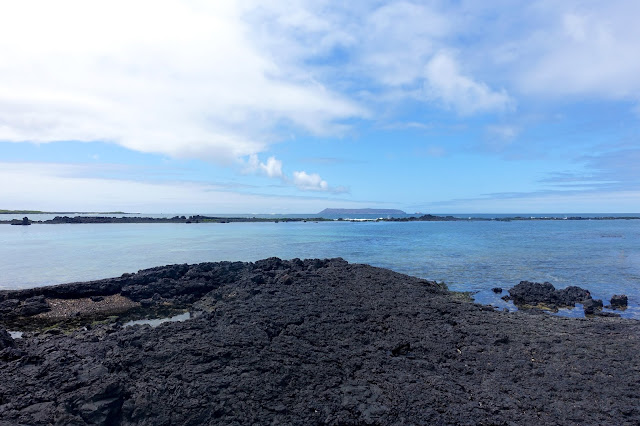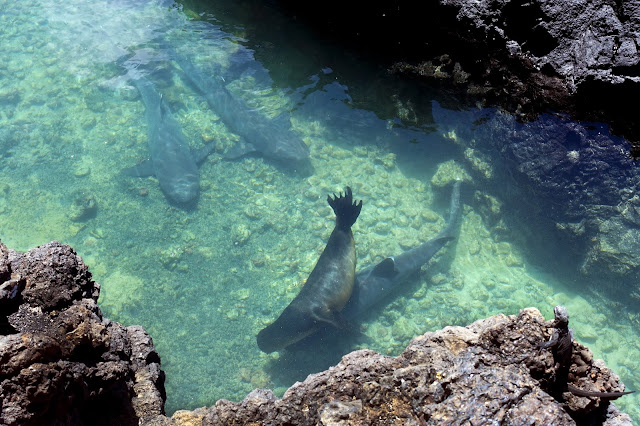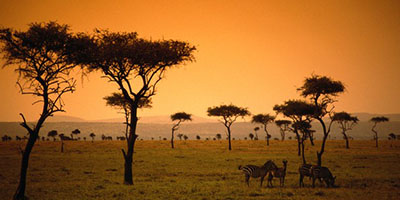Day 6: Isabela to Santa Cruz, Galapagos Islands
 |
| Tintoreras with Tortuga Island in the distance. |
This morning we explored Tintoreras via boat to finish up our last day on Isabela Island. I finally got to see the infamous bright blue feet on the blue-footed boobies! The blue feet are from the organic pigments found in the fish they consume. Foot color is important in selecting a mate - the brighter the blue, the better! It can also be an indication of age or health since foot color tends to diminish with age. A brighter color is indicative of a healthy immune system.
 |
| Blue-footed boobies. |
We also saw the adorable Galápagos penguins! I almost didn't see them though, their black coats made them blend right in with the rock. They are endemic to the Galápagos Islands and are the only penguin that can be found north of the equator. This is due to the cooler currents that are brought up from the south since temperatures can otherwise reach 82 degrees (F) on land.
 |
| Penguins! |
 |
| Some of the lava rock formations we walked on. |
 |
| This area was the easiest to get in and out from and had calm waters for snorkeling. |
Instead of swimming, Scarlett and I climbed along the rocks to see what we could find. Scarlett was super excited to find some huge marine iguanas. We even got to watch one swimming along in the water! Marine iguanas are also endemic to the Galápagos Islands and they primarily feed on algae. Their long claws allow for them to grab rocks under the water while foraging for food, keeping them from being carried off by strong currents. Their long tails help to propel them through the water and while the spines provide balance. Not only does their skin allow them to blend in with the volcanic rock, it also helps them to quickly absorb heat from the sun. This is especially important since the water can get pretty cold. They are the only iguana species in the world with such unique features that allow it to feed from the sea!
 |
| A marine iguana swimming back to shore after feeding. |
 |
| A yellow warbler that stopped to say hello. |
● ● ● ● ● ● ● ● ● ●
"It is not the strongest of species that survive, nor the most intelligent, but the one most responsive to change."
- Charles Darwin
● ● ● ● ● ● ● ● ● ●
Shark Alley
 |
| Shark Alley. |
Our guide told us about how sometimes sea lions will come over and “play” with the sharks during the daytime. As if on cue, a young sea lion popped up across the way and started making his way across the rock. It swam over to nip at the sharks fins, playing. Thankfully the sharks remained uninterested as I wasn't really in the mood to witness the murder of a sea lion! Hopefully he didn’t become dinner later as those sharks feed on baby sea lions and other small animals.
 |
| A young sea lion coming over to play with the sharks. |
 |
| Just playing around with the white-tipped reef sharks. |
 |
| The sea lion was having such a great time! |
We finished out the day with a choppy two hour boat ride back to Santa Cruz. I thought turbulence flying in and out of Quito was bad, but I’m pretty sure that experience topped it. Naturally, we had to stop the boat so Scarlett could climb up to the top where the bathroom was. Nothing like being in the middle of the open ocean with your 9-year-old hanging off the side of a boat to go up a ladder!
 |
| Out on the chair hammocks at the hotel. |
 |
| Our room at the Hotel Coloma. |



Comments
Post a Comment